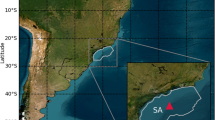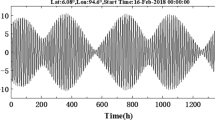Abstract
Significant wave height (SWH) plays an important role in supporting marine operational and maritime activities, such as shipping, construction, and monitoring. Forecasting of significant wave height has been studied numerically using various ocean wave models. This numerical approach needs to cover quite a large domain to get better result prediction. Moreover, this kind of computation can be costly if we consider acquiring higher resolutions. In this study, we propose a novel modeling approach based on long short-term memory (LSTM) neural network model with SWH observation data set as the only input data. The LSTM model is used in predicting SWH in several conditions of Indonesian waters, which cover areas of the open sea, straits, nearshore, and inner sea. Based on previous SWH input data, single-step predictions were carried out, as well as multi-step with lead times of 12-, 24-, and 48-h to come with a recursive scheme. Accurate results are obtained for single-step predictions with RMSE ranging from 5.53 cm (nearshore area) to 27.13 cm (open sea). Different results are obtained when predicting in a multi-step scheme, the predicted values are still not consistent in capturing the upward, downward trend, and the maximum and minimum conditions from SWH data pattern. In this study, it was found that the length of the data had a significant effect on the performance of the LSTM model in predicting SWH in a single-step. Meanwhile, in predicting multi-step, the model’s performance was influenced by fluctuations and data complexity.






Similar content being viewed by others
References
Akpınar A, van Vledder GP, Kömürcü Mİ, Özger M (2012) Evaluation of the numerical wave model (SWAN) for wave simulation in the Black Sea. Cont Shelf Res 50:80–99
Amrutha MM, Kumar VS, Sandhya KG, Nair TB, Rathod JL (2016) Wave hindcast studies using SWAN nested in WAVEWATCH III-comparison with measured nearshore buoy data off Karwar, eastern Arabian Sea. Ocean Eng 119:114–124
Berbić J, Ocvirk E, Carević D, Lončar G (2017) Application of neural networks and support vector machine for significant wave height prediction. Oceanologia 59(3):331–349
Gao S, Zhao P, Pan B, Li Y, Zhou M, Xu J, Zhong S, Shi Z (2018) A nowcasting model for the prediction of typhoon tracks based on a long short term memory neural network. Acta Oceanol Sin 37(5):8–12
Group, TW (1988) The WAM model—a third generation ocean wave prediction model. J Phys Oceanogr 18(12):1775–1810
Hochreiter S, Schmidhuber J (1997) Long short-term memory. Neural Comput 9(8):1735–1780
James SC, Zhang Y, O’Donncha F (2018) A machine learning framework to forecast wave conditions. Coast Eng 137:1–10
Jordan MI, Mitchell TM (2015) Machine learning: trends, perspectives, and prospects. Science 349(6245):255–260
Kazeminezhad MH, Siadatmousavi SM (2017) Performance evaluation of WAVEWATCH III model in the Persian Gulf using different wind resources. Ocean Dyn 67(7):839–855
Londhe SN, Panchang V (2006) One-day wave forecasts based on artificial neural networks. J Atmos Oceanic Tech 23(11):1593–1603
LeCun Y, Bengio Y, Hinton G (2015) Deep learning. Nature 521(7553):436–444
Mahjoobi J, Mosabbeb EA (2009) Prediction of significant wave height using regressive support vector machines. Ocean Eng 36(5):339–347
Malekmohamadi I, Bazargan-Lari MR, Kerachian R, Nikoo MR, Fallahnia M (2011) Evaluating the efficacy of SVMs, BNs, ANNs and ANFIS in wave height prediction. Ocean Eng 38(2–3):487–497
Mitchell TM (1997) Machine learning. McGraw-Hill, New York
Monbaliu J, Padilla-Hernandez R, Hargreaves JC, Albiach JCC, Luo W, Sclavo M, Guenther H (2000) The spectral wave model, WAM, adapted for applications with high spatial resolution. Coast Eng 41(1–3):41–62
Rizal AM, Ningsih NS (2020) Ocean wave energy potential along the west coast of the Sumatra island, Indonesia. J Ocean Eng Mar Energy 6:137–154
Rodriguez A, Sanchez-Arcilla A, Redondo JM, Bahia E, Sierra JP (1995) Pollutant dispersion in the nearshore region: modelling and measurements. Water Sci Technol 32(9–10):169–178
Shamshirband S, Mosavi A, Rabczuk T, Nabipour N, Chau KW (2020) Prediction of significant wave height; comparison between nested grid numerical model, and machine learning models of artificial neural networks, extreme learning and support vector machines. Eng Appl Comput Fluid Mech 14(1):805–817
Shrestha DL, Solomatine DP (2006) Machine learning approaches for estimation of prediction interval for the model output. Neural Netw 19(2):225–235
Son G, Choi H, Lee JH, Kang P (2020) Significant wave height regression from a raw ocean image with convolutional LSTM and 3D convolutional networks. J Korean Oper Res Manag Sci Soc 45:11–24
Umesh PA, Swain J, Balchand AN (2018) Inter-comparison of WAM and WAVEWATCH-III in the North Indian Ocean using ERA-40 and QuikSCAT/NCEP blended winds. Ocean Eng 164:298–321
Wei CC, Hsieh CJ (2018) Using adjacent buoy information to predict wave heights of typhoons offshore of northeastern Taiwan. Water 10(12):1800
Zamani A, Solomatine D, Azimian A, Heemink A (2008) Learning from data for wind-wave forecasting. Ocean Eng 35(10):953–962
Zheng K, Sun J, Guan C, Shao W (2016) Analysis of the global swell and wind sea energy distribution using WAVEWATCH III. Adv Meteorol 2016:8419580
Acknowledgements
This research was funded by Institut Teknologi Bandung Research Program with contract number: 138/IT1.B07.1/TA.00/2021. We gratefully thank to ITB for the supports. The authors also would like to thank to the Agency for the Assessment and Application of Technology of Indonesia (BPPT) for providing the wave data set.
Author information
Authors and Affiliations
Corresponding author
Ethics declarations
Conflict of interest
The authors declare that they have no conflict of interest.
Additional information
Publisher's Note
Springer Nature remains neutral with regard to jurisdictional claims in published maps and institutional affiliations.
Rights and permissions
About this article
Cite this article
Abdullah, F.A.R., Ningsih, N.S. & Al-Khan, T.M. Significant wave height forecasting using long short-term memory neural network in Indonesian waters. J. Ocean Eng. Mar. Energy 8, 183–192 (2022). https://doi.org/10.1007/s40722-022-00224-3
Received:
Accepted:
Published:
Issue Date:
DOI: https://doi.org/10.1007/s40722-022-00224-3




